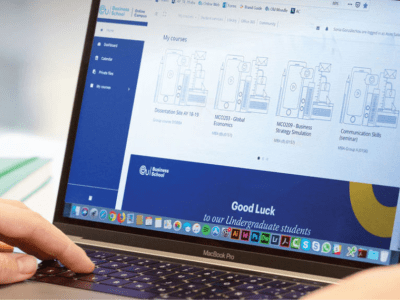The web design and marketing spaces move at a breathtaking pace. Every year, new and potentially game-changing technologies are implemented by forward-thinking companies.
But it can be difficult to make sense of all these changes and to separate passing fads from genuine innovations. We invited co-founders of MBJ London Toni Horn and Julian Baladurage, an EU alumnus, to talk about the most important trends currently shaping web design and marketing.
MBJ London is a digital agency that specialises in building and managing websites for modern businesses. They pioneered the “website-as-a-service” model, and handle all aspects of their clients’ online presence.
In their session for EU students, Julian and Tony covered six major trends that will likely shape the corporate world for years to come.
1. User-Centered Design
In the context of the work MBJ London does, user-centred design involves tailoring websites to cater to a variety of customer personas and use cases, rather than to a single, general audience. This approach takes into account the different needs people have in different contexts.
And context is the key word here. 57% of people, for instance, won’t recommend a business if their website is poorly designed for mobile. This statistic demonstrates the different requirements web users have in different situations. Someone browsing the internet on their commute won’t engage with a website that’s designed exclusively for desktop use.
What’s more, there’s been a general shift in focus towards optimizing every aspect of the user experience. More and more business leaders and marketers are asking, “How can we personalize better and create unique customer experiences?”
2. Emotional Design
For a long time, the central focus in web design was on usability. Analytics were primarily used to drive greater usability with a view to boosting metrics like engagement and conversions.
In recent years, however, there’s been a mainstream shift towards emotion-optimised design. Emotion-centred design is essentially about triggering an emotional reaction in the user.
Designers have access to an array of tools for cultivating emotional reactions, of which there are three levels :
- Visceral – An instinctive and immediate emotional response based on the visual appearance of something.
- Behavioural – Emotions prompted by using and interacting with something.
- Reflective – Emotions that are evoked when weconsciously reflect on the visual effect and user experinece of a product or service.
Don Norman, one of the founders of this approach, said that great design triggers all three of these emotions. But the speakers were keen to emphasise that packaging emotional triggers within design is very difficult to achieve.
To understand this concept iIt’s helpful to think about which brands spark a strong reaction in you. Often, you’ll find that emotional triggers are very subtle and hard to pin down.
3. Artificial Intelligence
Artificial intelligence has impacted web design in two significant ways. The first centers around website-building software. However the speakers pointed out that while so-called AI-powered tools represent a notable trend, they often rely on sophisticated automation systems rather than true artificial intelligence. How this space evolves, and whether or not it will become more advanced, remains to be seen.
The second way is much more interesting. Artificial intelligence can be used to interpret the ways users behave online and to deliver personalized experiences.
One compelling example that is leveraged at MBJ London is the use of AI to enable auto-updating personas. These are customer “templates” that website visitors fit into. And complex algorithms can refine them based on new information and data. These personas grow “smarter” over time, allowing for even more personalised and rewarding experiences.
4. Voice User Interfaces
By 2020, at least 50% of smartphone users will regularly engage with voice user interfaces – Alexa and Siri are the two most well-known examples. This technology is expected to become increasingly relevant in all areas of our life, and the speakers highlighted two particularly important trends.

Voice technology emerged as an attempt to make standard visual interfaces more accessible. But there are still many challenges involved in translating entire websites so that they’re consumable through voice user interfaces. It’s expected that modern applications will evolve in exciting ways to tackle this problem.
Another noteworthy trend is the rise of incentives to encourage people to talk politely to machines. Many parents, for example, are concerned that children are becoming less polite because of the way they interact with voice user interfaces. This is leading to a paradigm shift towards human-like assistants and voice chatbots.
5. Social Listening
Social listening is now being used by many companies to inform critical decisions. Fundamentally, this marketing strategy is about monitoring and collecting data on social platforms and analysing it for insights related tothe collecting company and its competitors.
Social listening has proven to be a useful source of feedback about everything from product experience to customer-facing procedures and support.
Notably, artificial intelligence, which is increasingly being tailored for social listening, has allowed businesses to generate significant insights. Large corporates with complex hierarchies are shaping their internal processes to account for information gathered through social listening.
6. Chatbots
Machine learning and artificial intelligence are being used to power a new cohort of chatbots. And businesses are increasingly looking to capitalize on this technology. By 2023, 40% of customers will have interacted with a chatbot.
Companies of all shapes and sizes are leveraging chatbots to ensure that only the highest-priority issues are directed to agents. This often leads to significant savings in time and resources. That said, the same companies often struggle to find a balance between chatbots and human interaction. And getting it wrong often prompts customers to leave bad reviews.
Engineered empathy is one way of tackling this problem. It’s very difficult, however, to build a chatbot that can respond to specific stages of the customer journey and sound genuinely human. So this challenge represents a major area for innovation going forward.
Finally, many solutions which have been restrictively expensive are now becoming available to smaller businesses. This trend is already proving a game-changer for the SMB sector.
Excited by Shifts in the Web Design and Marketing Sectors?
If you’re excited by the trends outlined in this post, then it’s worth considering a career in the corporate space. At EU Business School, you’ll acquire the skills and experience you need to thrive as a business leader. In particular, take a look at our Bachelor of Arts in Digital Business, Design & Innovation and the Master in Innovation and Entrepreneurship.










